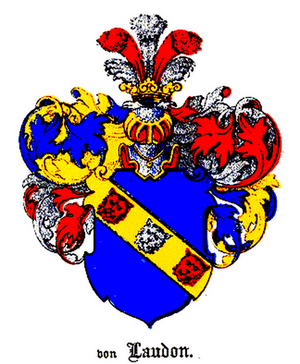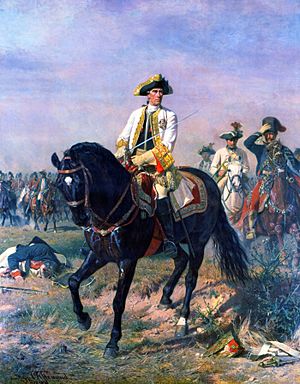Ernst Gideon von Laudon facts for kids
Quick facts for kids
Ernst Gideon von Laudon
|
|
|---|---|
 |
|
| Born | 13 February 1717 Tootzen Manor, Tootzen, Swedish Livonia (in present-day Toce, Madona Municipality, Latvia) |
| Died | 14 July 1790 (aged 73) Nový Jičín, Moravian Margraviate, Holy Roman Empire |
| Buried |
Hadersdorf, Vienna
|
| Allegiance | |
| Service/ |
Imperial Army |
| Years of service | 1732–1790 |
| Rank | Generalfeldmarschall |
| Battles/wars | War of the Polish Succession
Russo-Austrian-Turkish War
Austro-Turkish War |
| Awards | Military Order of Maria Theresa |
Ernst Gideon Freiherr von Laudon (born February 13, 1717 – died July 14, 1790) was a famous military leader. He was born in Livonia, which is now part of Latvia. Laudon became one of the most successful generals for Austria. He was a strong opponent of Frederick the Great, the King of Prussia. Some even say that the famous Russian general Alexander Suvorov learned from Laudon. From 1789 until his death, Laudon was the military governor of Habsburg Serbia. He worked with local resistance fighters there.
Contents
Early Life and Military Start
The Laudohn family came from a mix of German and Latgalian backgrounds. They had lived in the Tootzen area of eastern Livonia since before 1432. Ernst Gideon's father, Otto Gerhard von Laudohn, was a retired lieutenant-colonel from the Swedish army.
After the Great Northern War, Livonia became part of Russia. So, in 1732, young Ernst was sent to join the Imperial Russian Army. He was a cadet, which is like a trainee officer.
First Battles
Laudon fought in the War of the Polish Succession. In 1734, he took part in the Siege of Danzig. He also marched against French troops near the Rhine River in 1735. Later, he joined the Turkish campaign.
After the war ended in 1739, Laudon returned to the Russian court. He was not happy with his future in the Russian Army. In 1741, he left the Russian service. He tried to join King Frederick the Great's army, but Frederick said no.
Joining the Austrian Army
Laudon had better luck in Vienna, Austria. He became a captain in a special unit called a Freikorps, led by Baron Franz von der Trenck. During the War of the Austrian Succession, he fought in many battles. He was wounded and captured in Alsace, but was soon released.
Rise to Fame in the Silesian Wars
Laudon continued to serve under Trenck in 1745. This was during the Second Silesian War against Prussia. He showed great skill as a leader of light troops. He also fought in the Battle of Soor.
Soon after, he left Trenck's unit. He did not like the rough behavior of some of his fellow soldiers. After a long wait, he finally received a regular commission. He became a captain in a frontier regiment. For the next ten years, he worked in the Karlovac area, doing military and administrative tasks. He even built a church and planted an oak forest there.
Seven Years' War Begins
Laudon was a lieutenant-colonel when the Seven Years' War began. This war made him famous. At first, a general named Wilhelm Reinhard von Neipperg did not want him. But Chancellor Wenzel Anton Kaunitz insisted, and Laudon was promoted to colonel.
He quickly proved his worth. He led a successful night raid on Ostritz in 1757. That same year, he fought in Bohemia and Saxony. He became a major-general of cavalry. He also received the Military Order of Maria Theresa, a very important award.
Key Victories and Honors
In 1758, Laudon got his first chance to command a large force. He did so well that Frederick the Great had to stop his attack on Olomouc. This was the Battle of Domstadtl on June 30. For this, Laudon was promoted to lieutenant-field-marshal.
He continued to be a brave and active commander. After the Battle of Hochkirk, he was made a Freiherr (a noble title) by Empress Maria Theresa. She also gave him the Grand Cross of her military order and an estate in Bohemia.
In 1759, Laudon led the Austrian troops who joined the Russians. Together, they won a huge victory at the Battle of Kunersdorf. As a result, Laudon was promoted again. He became commander-in-chief in Bohemia, Moravia, and Silesia.
In 1760, he destroyed a whole part of Frederick's army at the Battle of Landeshut. He also captured the important fortress of Glatz.
Challenges and End of War
Laudon faced a tough defeat at the Battle of Liegnitz in 1760. He felt that the main Austrian army, led by Daun and Lacy, did not support him.
In 1761, he continued fighting in Silesia. His Russian allies were not as bold as before. Attacks against Frederick's strong camp at Bunzelwitz failed. However, Laudon brilliantly captured Schweidnitz on the night of September 30, 1761.
Laudon was always active and daring. This was different from the more cautious strategies of Daun and Lacy. This difference often caused arguments between them.
Later Career and Final Years
After the war, Daun became the main commander of the army. Laudon's role became less central. Frederick the Great and others tried to get Laudon to join their armies. Laudon did not accept these offers, but talks went on for years.
When Lacy took over the Council of War, Laudon became inspector-general of infantry. But disagreements between Laudon and Lacy continued. When Joseph II became emperor, Laudon retired to his estate.
However, Empress Maria Theresa and Kaunitz convinced him to return. In 1769, he became commander-in-chief in Bohemia and Moravia. He held this post for three years.
Laudon wanted to retire again. But Maria Theresa persuaded him to stay in the army. She even bought his estate from him in 1776, as its value had dropped. Laudon then moved to Hadersdorf near Vienna. Soon after, he was made a Field Marshal.
In 1778, the War of the Bavarian Succession began. Laudon and Lacy commanded the two armies. This time, Laudon seemed less successful, while Lacy gained new honors.
For two years, Laudon lived quietly. But in 1787, a new war with Turkey started. The generals fighting this war were not doing well. So, Laudon was called back to duty for the last time.
Even though he was old and not well, he was the true commander-in-chief. In 1789, he achieved a final great success. He captured Belgrade in just three weeks.
Laudon died the next year, on duty in Moravia. His last role was commander-in-chief of Austria's armed forces. This position was created especially for him by the new emperor, Leopold. Laudon was buried at Hadersdorf. Eight years before he died, Emperor Joseph had a marble bust of Laudon placed in the council of war chamber.
His nephew, Johann Ludwig Alexius von Loudon, also became a successful military leader. He fought in the Revolutionary and Napoleonic Wars.
See also
 In Spanish: Ernesto Gedeón von Laudon para niños
In Spanish: Ernesto Gedeón von Laudon para niños




